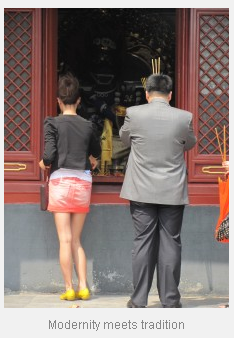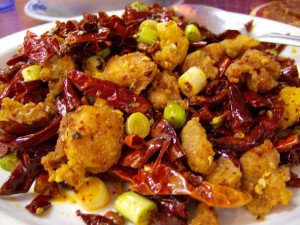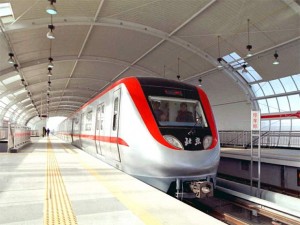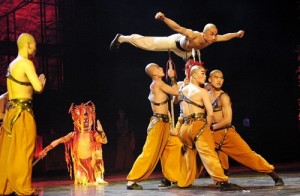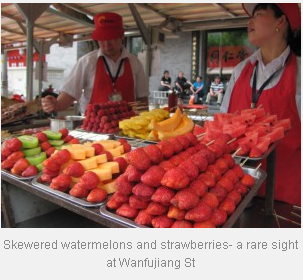This article is written by Meena Venkataraman, who is one of India’s leading travel writers with extensive travel experience.
China fascinated…Five long years after I first visited I can still vividly remember the five weeks I spent there. For no good reason I decide I would go through with the exercise of blogging about it.So here I go..
We first landed in Shanghai. Shanghai is in every sense the realization of the Chinese dream. Its China’s advertisement of success to the rest of the world. And its such a wow city!
 Shanghai
ShanghaiShanghai is a veritable concrete jungle. A colleague of mine told me that 1/3 of all the world’s concrete was possibly found here The evidence in favor of that argument was so overwhelming that it did not occur to me that I should doubt that statement. Though this is what the world was to see of China I was told that vast areas of China were poor and economically deprived and many people faced the same struggles that others from across the world face in the battle for survival. I did not get to see the other side as my travels only took me as far as Shanghai and Beijing. But someday I hope to go back and see much more of this vast ancient country. Though China’s emergence as an economic giant is fairly recent, trade between India and China go a long way and has been mentioned in several Indian books.
 A view of Pudong
A view of PudongAs most big offices which have made their foray into the vast Chinese market place, ours was in the Free trade zone in Pudong, which means ‘East of the River’ in Chinese. The river in question is Huangpu , a tributary of the great Yangtze before it empties into the East China Sea. the lifeline of Shanghai, the name of which means Yellow Bank River , it also serves as a major waterway. The impressive Shanghai metro has several branches which run under the river. Morning comes and we see a flurry of cyclists cross our path. I have never seen so many people cycle to work, the green alternative to motored transport. The cycle lanes have been beautifully planned and built hugging the huge motorways, all the way upto the Special Economic Zone in Pudong.
 Typical Shanghai Cuisine
Typical Shanghai CuisineThe world arises in Language they say, and the purport of the statement hits you square on the face when you visit China. They had no need for English except in the recent past, and so we had no way of communicating. We realize that even Sign language has heavy cultural biases and what we thought we were saying was always met with blank stares. Our way around the problem was to get small bits of information written on paper in Chinese which we would hold up :). Limited but effective. Being a vegetarian, I had my little sheet saying I do not eat meat or fish. The communication barrier surpassed, there really is nothing to worry. Instructions are followed to a T. :). While we are on the topic of food, being a vegetarian I had absolutely no problems here. There was plenty to eat. The average Chinese meal comprises of a couple of serving of meat and a couple of servings of vegetable, along with a small quantity of rice. I even tried a little imitation meat, made entirely of Soya. The cultural nuances of Chinese eating would have been lost, if we had decided to get rid of the chop sticks and stick to forks instead. For each meal is served on a circular table, from which you pick up food and eat. Rice was a smaller bowl than we expected and was often eaten alone, picking up the grains with the chopstick, without any accompaniment to go with it. That also explains why we did not see too many fat people there. The other reason as explained to us by a colleague was the enormous amounts of green tea the Chinese consume. Even hotels do not serve water with a meal. Its only Tea that is drunk to sate parched throats.
 Xintiandi
Xintiandi
One evening we visited Xintiandi, the flashy and affluent area laden with shops and eateries and with a beautiful view of the skyline. Xintiandi means ‘New Heaven and Earth’. Very close by is the site of the first communist party of China. In this place of bright lights, big hoardings, shopping malls and narrow cobblestone streets we stroll around.
 The Jinmao Tower & The World Financial Center, Shanghai
The Jinmao Tower & The World Financial Center, ShanghaiShanghai’s skyline is impressive. And no better way to see it then from the top of one of the tallest buildings , ‘The Pearl Tower‘. All around the Huangpu river snakes around the city meandering its way into the sea. Tiny barges flicker in the distance. The Shanghai World Financial Center, towers like a giant above midgets. At 492 m, its the tallest building adorning the skyline.
Shanghai is a spectacular city. First opened up to trade under the ‘Treaty of Nanking’ in 1842, to mark the end of the first Opium war, the city has grown in stature as one of the foremost commercial hubs in the world. The city has known a long history and has been at the center of many a conflict to where she stands now. Shanghai was the succor to Russians and Jews fleeing persecution from the newly established Soviet Union and was also the center of the radical leftist movement. Prized and coveted though out history, Shanghai is a gem of a city. All around us we see evidence of China’s growth as a global power. But as we wander along the tiny lanes leading up to the Jade Buddha temple, we also see evidence that some have been left behind.
Meena Venkataraman
30 Dec 2010
http://traveltazzels.blogspot.com/2010/12/memories-of-shanghai.html
Average Rating: 4.9 out of 5 based on 187 user reviews.
